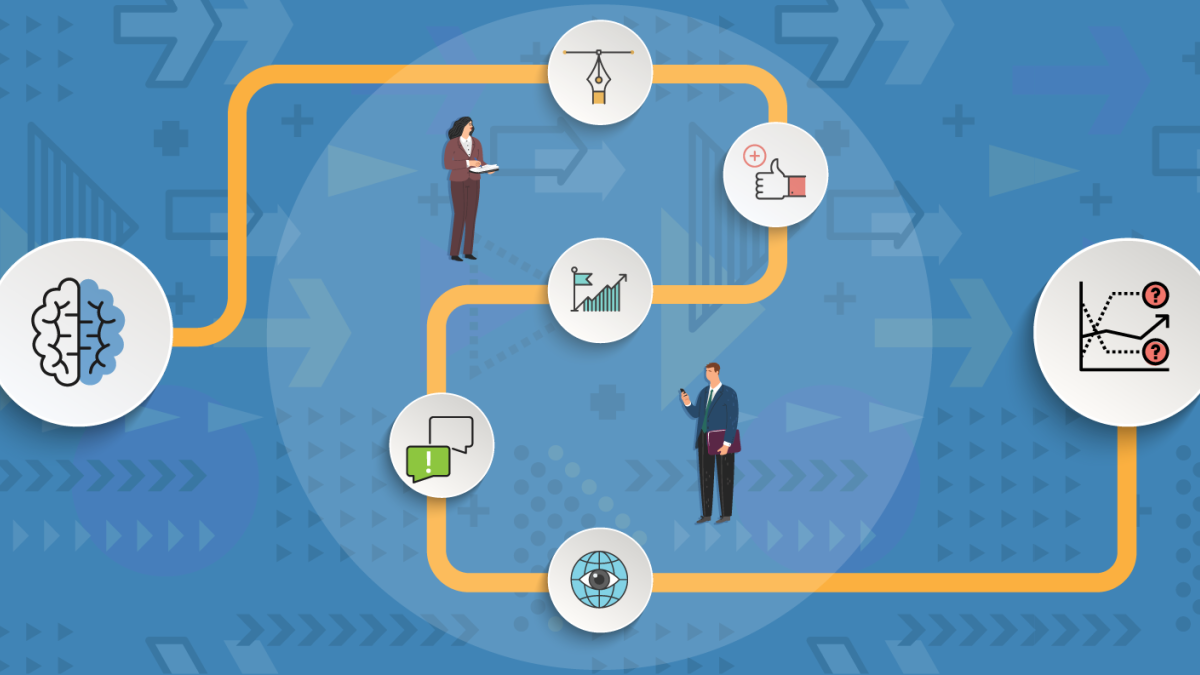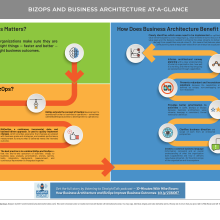Biz Arch + BizOps. How do they fit together and what is BizOps anyway?
This installment of StraightTalk explores the topic of BizOps, how it relates to other approaches, and how business architecture can help. Putting these topics together requires unique thought leadership and experience, so we brought in business architecture and enterprise architecture guru Mike Rosen as our guest star. What follows is his enlightening podcast upon which this post was based. Enjoy!
Disclaimer: we’ve made some tiny adjustments for our typical StraightTalk-style: the bold headings represent StraightTalk asking the questions and our guest, Mike, responds in turn.
The podcast is thoughtful and engaging, so make sure to check it out: 10-Minutes With Mike Rosen: How Business Architecture and BizOps Improves Business Outcomes.
So, what is BizOps?
Mike: “You’ve probably heard of DevOps, or development to operations, as an extension to Agile development. BizOps extends that further to business to operations, or sometimes it’s called BizDevOps, or business to development to operations to make it a bit more specific.
In some organizations, BizOps is used to refer to a cross-functional special team, often of internal consultants, that help in different situations where quick business action and cross-organizational scope is required. BizDevOps is a continuous, incremental, data and business-driven approach for quickly implementing changes and assuring that they are aligned with business goals and strategies, and, that measures what is delivered to ensure that it is achieving the intended outcomes.
The best practice is to combine both of these so that the end-to-end spectrum of activities, from triage, to business case, analysis, prioritization, stories, sprints, tests, integration, deployment, measurement and continuous improvement is integrated together.”
How does BizOps relate to other approaches such as Agile, SAFe or DevOps?
Mike: “All of these approaches share a similar set of principles, such as:
- Taking an economic view
- Systems thinking
- Preserving options
- Delivering incrementally with fast, integrated learning cycles
- Managing workflow, cadence and synchronization
BizOps follows the principles and extends them to specifically include continual business outcomes and integration.”
Why is the concept of BizOps important? What benefits does it provide?
Mike: “With Agile and DevOps for example, we see that organizations are building things faster, and that what is built is generally better quality. But sometimes those efforts are siloed, so organizations are still creating redundancies and inconsistencies, or optimizing a narrow approach that suboptimizes the whole.
BizOps’ goal is to make sure that organizations are building things faster and better, AND that they are building the right things – the things that provide the business outcomes that the organization is trying to achieve.”
Where does business architecture fit within BizOps and how can business architecture help BizOps?
Mike: “Architecture can help in a variety of ways, such as providing the enterprise scope that is sometimes missing, and better integrating with the overall Agile and DevOps approaches. I’ve had great results doing this, but it would be a topic for another discussion.
Business architecture can help enhance the DevOps approach, particularly with the capabilities that provide an understanding of what an organization does and the value streams that describe how it delivers value.”
Value streams are also used in SAFe. What’s different with business architecture?
Mike: “First, let’s distinguish between the two kinds of value streams in SAFe: operational value streams and development value streams. Business architecture value streams align fairly well with what SAFe calls operational value streams.
But, SAFe leaves it mostly up to the reader to understand what a value stream is, and how to develop one. Business architecture provides a much more consistent and formal method and definition of value streams, so that when they are used to help prioritize activities in SAFe or DevOps or BizOps, they are actually much better formed and have a much broader enterprise scope.
Also, the capability-to-value stream mapping of business architecture clearly identifies what areas need to be implemented or uplifted to improve value. The measurement aspects of value streams make sure that we are focused on the most important value gaps, and finally, the specific identification of value items identified through value streams provide specific areas for hypothesis, measurement and testing as a part of our continuous learning loop.”
How can capabilities help to create an intentional architecture and guide feature prioritization?
Mike: “When we think about capabilities in business architecture, we generally would see a capability map for an entire organization. This means that we’ve already looked at the organization from an enterprise scope in terms of what it does, and because the capabilities are unique, non-overlapping and non-redundant, we’ve taken care of the inconsistencies and redundancies that sometimes occur.
Now, in SAFe or in DevOps you have the idea of having an architectural runway where architecture is a few steps ahead of every sprint so that when we implement features, we have the architecture in place to enable them. Because capabilities give us an understanding of what we have and where we are going, we also have the ability to understand what the architectural runway – or what I like to call an intentional architecture – needs to look like so that we are able to plan better for the architecture enablers as sprint-sized pieces of work that we can fit into the overall increment.
What we also see is that the features needed to enhance the value streams to deliver the value that we want to prioritize, turn out to be very well matched to capabilities, typically around a level 3. So, this means that the features that get planned in our DevOps and SAFe planning have already been vetted from an enterprise scope perspective. We can also understand how well capabilities are performing along with a variety of other things that capability-based planning allows us to accomplish.
Here is a helpful diagram that summarizes the Why's, What's, and How's of BizOps and how business architecture can benefit BizOps:
Anything else?
Mike: “I’ve been doing this for a long time. The idea that architecture is somehow incompatible with Agile, DevOps and BizOps is just wrong. Architecture enables all of these practices – it enhances them. BizOps uses business architecture to better understand the business, and to ensure that business outcomes are actually being achieved.
But, for this to work, architects have to adopt the ethos of Agile and DevOps. The architecture approaches of the past don’t work anymore. We have to do things differently to fit into this brave new world. But when we do, fantastic outcomes occur.”
More Good Stuff...
You’ll notice that this section is a little light on this installment, but that just means that the topic and how we’ve positioned it is cutting edge!
10-Minutes With Mike Rosen: How Business Architecture and Biz Ops Improve Business Outcomes (StraightTalk podcast): Just in case you missed that link right there in the beginning, make sure to check out Mike’s engaging podcast, which was the basis for this post.
Top 5 Inspiring TED Talks for Agilists (TED Talk): In case you haven’t seen these talks, they are all gems to reenergize your mind with amazing ideas.

